Once, the Royal Navy was uncontested master of the seas, the most powerful fleet on Earth. Although the last century has been largely a story of decline from that position, it remains a capable force, in the first rank of the world's navies and one well-suited to protecting Britain's interests abroad. And the future looks quite bright, with new ships projected in the latest review backed up by actual funding.
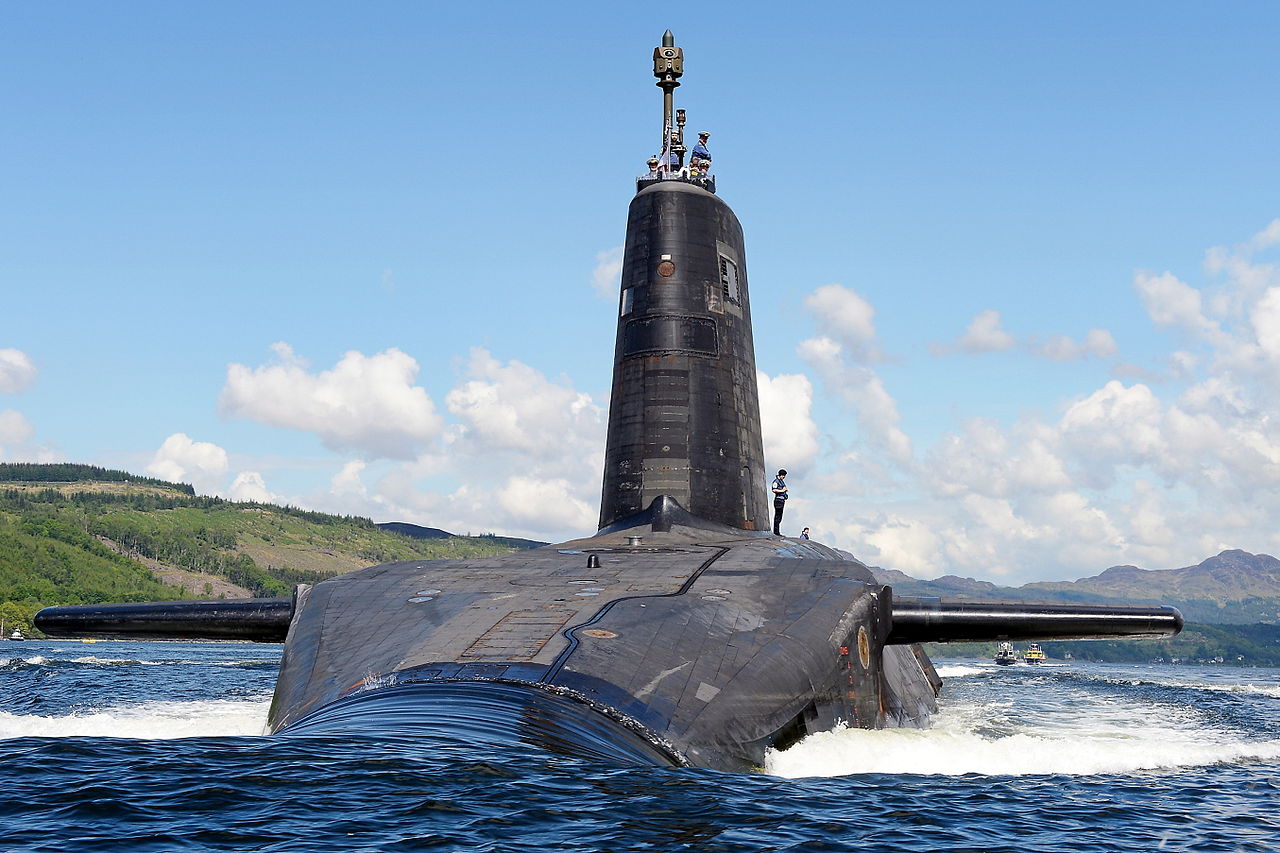
SSBN Victorious
British strategy documents list five missions for the RN: maintenance of the Continuous At Sea Deterrent, provision of the Carrier Strike Group, protection of the seas immediately around Britain, power projection through amphibious operations and forward deployment of a small number of warships worldwide. The first of these missions is entrusted to the RN's four Vanguard class SSBNs, replacement for the original Polaris Boats, and scheduled to be replaced in turn by the new Dreadnought class. At least one of these boats has been at sea continually since 1969, ready to strike Britain's enemies if the worst should happen.
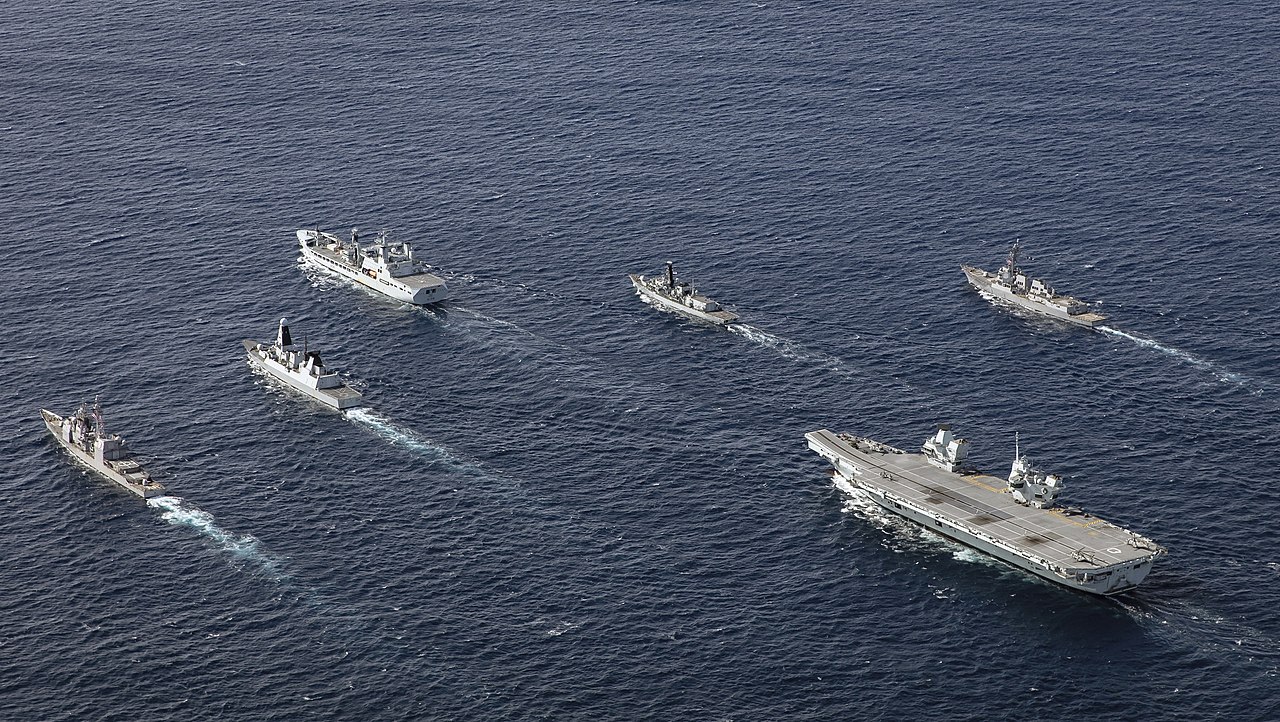
HMS Queen Elizabeth operates with her strike group
Besides the SSBNs, the crown jewel of the RN is undoubtedly the two Queen Elizabeth class aircraft carriers, the largest (65,000 tons) and most advanced carriers outside of the USN. Commissioned in 2017 and 2019, they give the RN excellent power projection with their wing of 24 F-35Bs, which will usually be provided via a unique joint effort of the RN, RAF and USMC. The only real downside to these ships is that they are equipped with a ski jump instead of a catapult and lack arrestor wires, meaning that besides the F-35B, only helicopters can operate off of them.1 Normally, they would carry seven or so Merlins, a mix of birds equipped for airborne early warning and anti-submarine missions. They also have a secondary capability as amphibious carriers. Queen Elizabeth deployed for the first time in 2021, with her strike group operating in the Western Pacific, an increasing global hotspot thousands of miles from the UK or any of its territories.
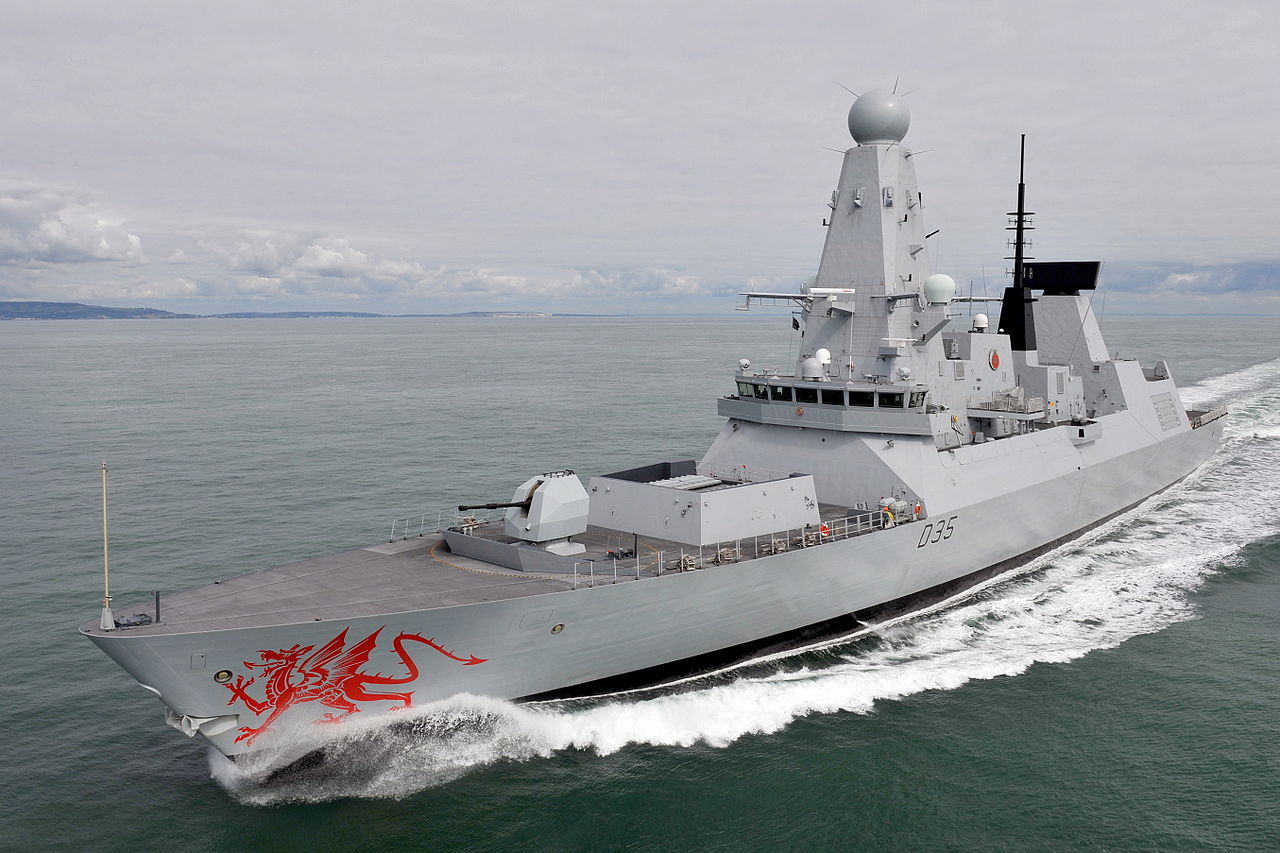
Type 45 HMS Dragon
But a carrier can't operate alone, and will be escorted by ships drawn from a force composed of six Type 45 air defense destroyers and 12 Type 23 frigates. The Type 45s are broadly equivalent to the American Burkes, with a high-end air defense system and a 32-cell Sylver VLS for the Aster missile. The Type 23 was originally built as a specialist anti-submarine ship in the waning days of the Cold War, and 8 of the vessels have received the new Type 2087 sonar to keep them on the cutting edge of ASW, while the four oldest ships have been classed as general-purpose escorts, but all have the Sea Ceptor point-defense SAM. Both types are also armed with a 4.5" gun and can carry a Wildcat helicopter.
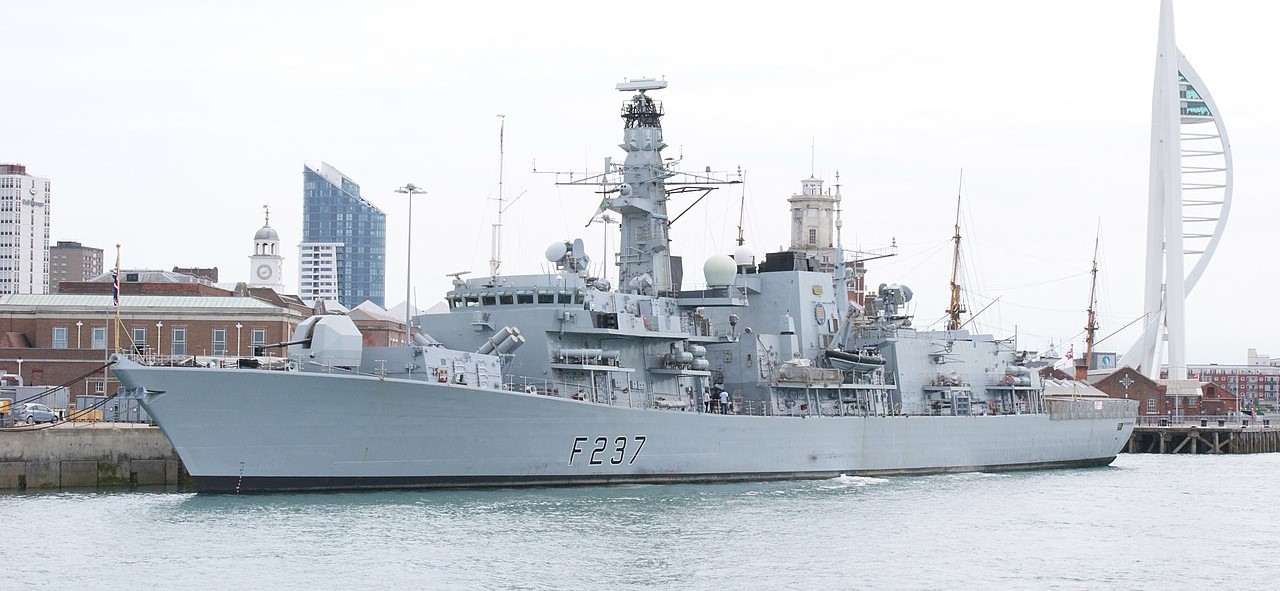
Type 23 HMS Westminster
The Type 23s are nearing the end of their service life, and work on their replacements is underway. The anti-submarine vessels will be replaced by the Type 26 frigate, a somewhat larger vessel that should finally give the British surface fleet the long-range strike capability the Americans have long enjoyed with Tomahawk. The class has also been sold to Canada and Australia for their fleets. For lower-end missions, five Type 31 frigates are on order, which lack the anti-submarine capability of the Type 26, but have the Sea Ceptor SAMs, a 57mm gun, and a helipad, essentially the minimum viable modern warship.
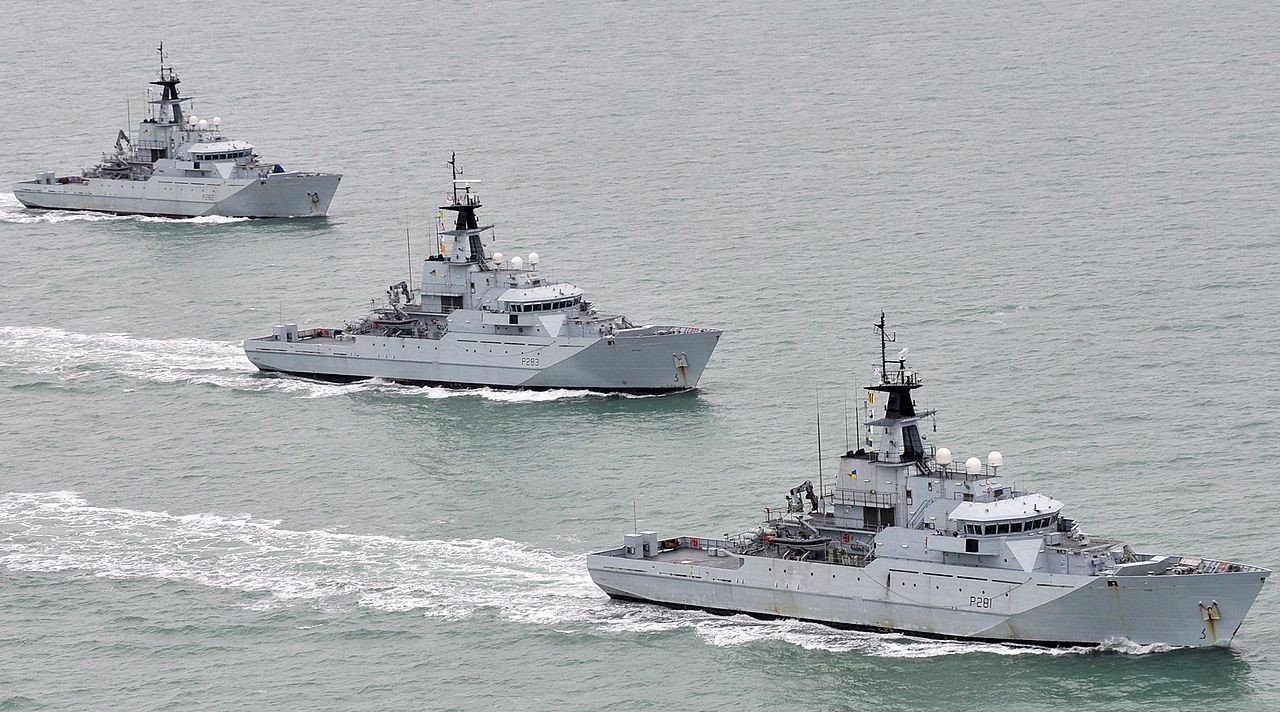
Three River class OPVs operate together
But the RN's limited escort force means that it isn't possible to use these ships for all of its missions, and they're backed up by the eight River class Offshore Patrol Vessels. OPVs are even below Type 31 standards, essentially a platform with some sensors, decent seakeeping, a light gun and a flight deck. In fact, the Rivers make up the bulk of the forward-deployed naval forces, with one at Gibraltar, another serving as guardship in the Falklands, a third in the Caribbean and a fourth based in Singapore. A Type 23 is also based at Bahrain, in the Persian Gulf, along with a group of minehunters to make sure that vital waterway stays open.
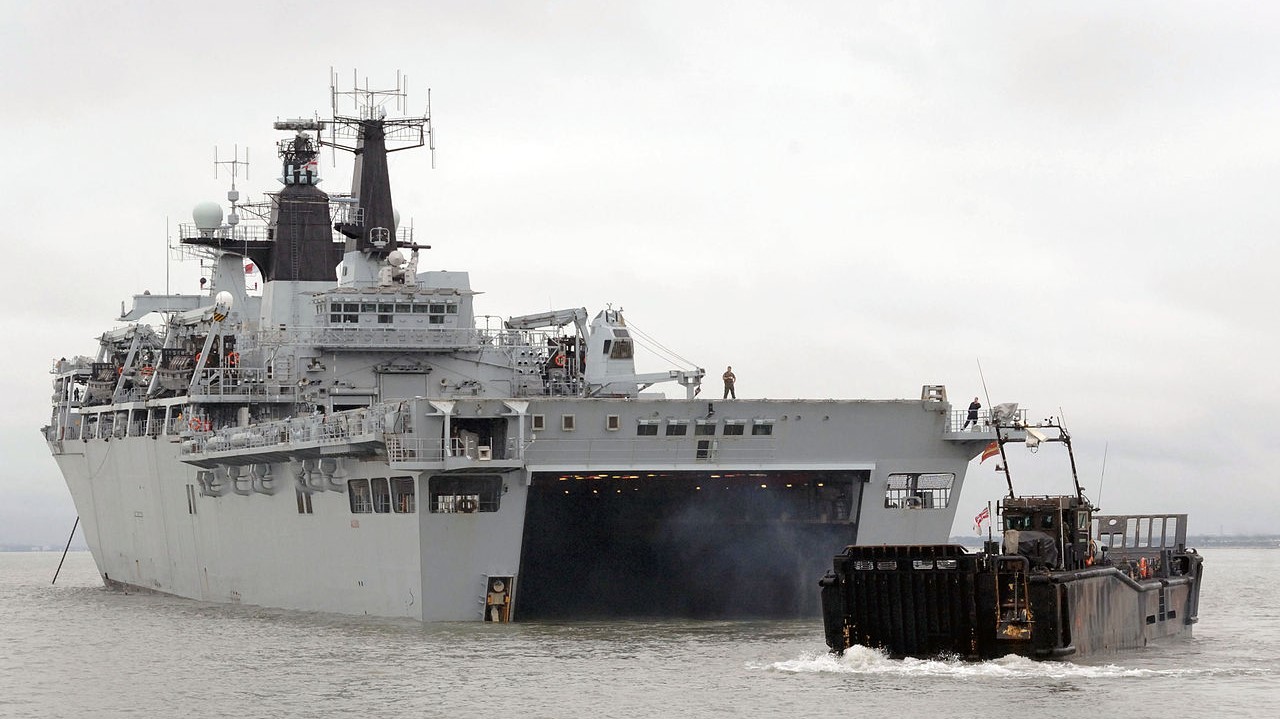
A landing craft operates from HMS Albion
The last mission is amphibious warfare. Britain has recently abandoned the long-held mission of landing a brigade in favor of a battalion-level capability, probably spread across several groups with a company each, drawn from the Royal Marines. The current plans have one group in European waters, composed of an Albion class LPD and a Bay class LSD, and another Bay in the Indian or Pacific Ocean, modified into a "Littoral Strike Ship", probably with better aviation and command capabilities.
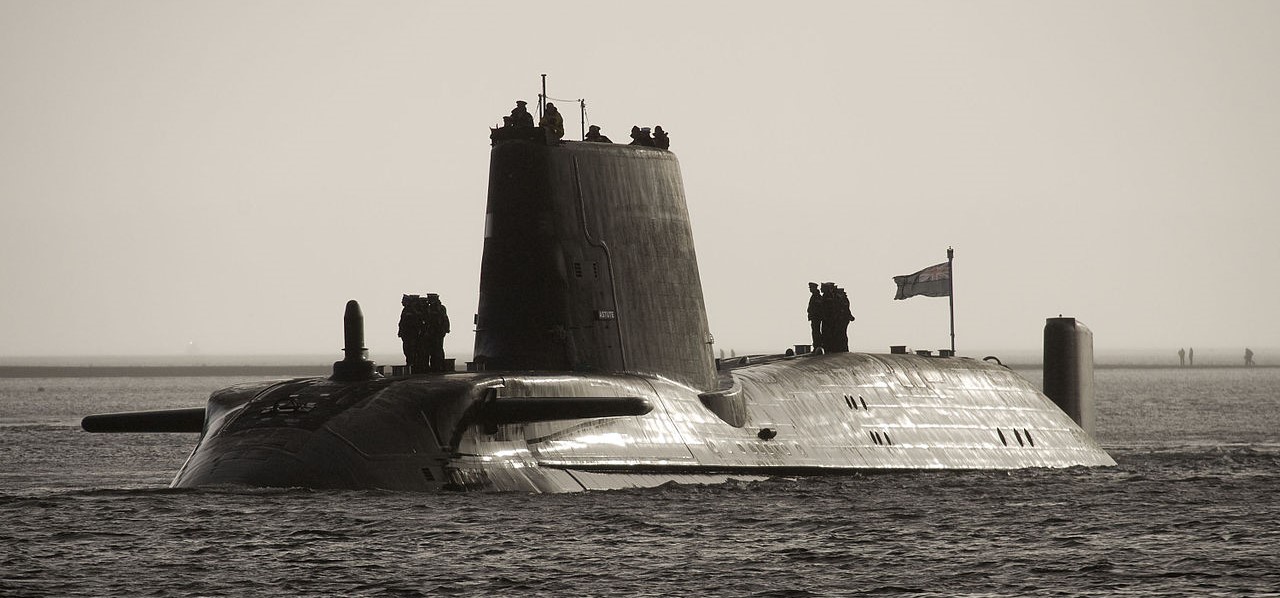
HMS Astute on the surface
Two more pieces of the Royal Navy deserve mention.2 The first is the attack submarine force, currently composed of five units of the Astute class and one older Trafalgar. Two more Astutes are under construction to bring the force back to its full intended strength. The British SSNs are incredibly capable units, armed not only with torpedoes and Harpoon, but also Tomahawk, and the equal of the American Virginias except for slightly lower speed.
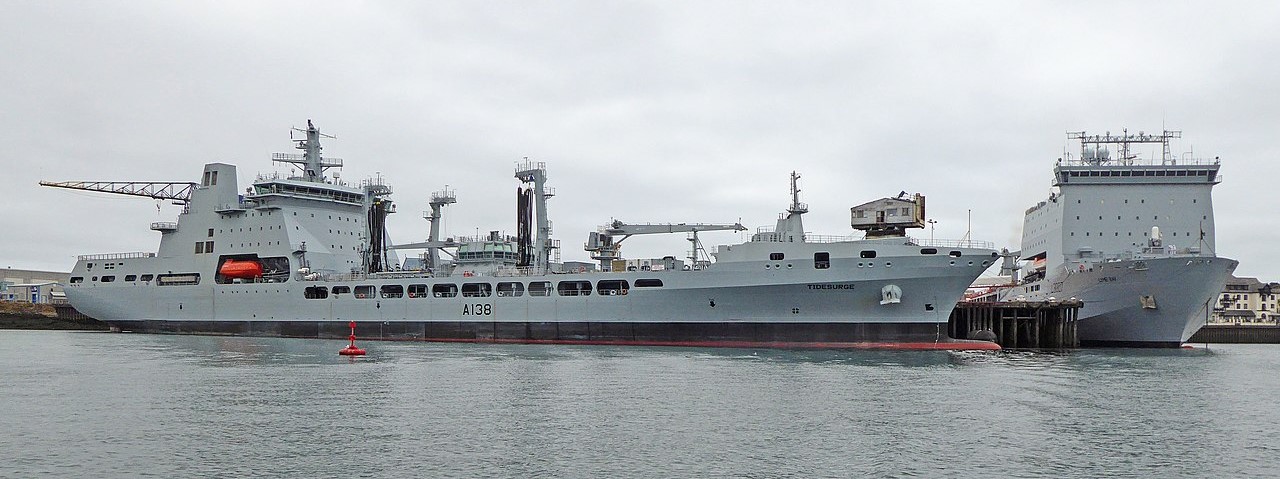
RFA Tidesurge and RFA Lyme Bay
Second is the auxiliary force, primarily provided by the Royal Fleet Auxiliary (RFA), a civilian-manned organization similar to the American MSC. It operates the Bays, as well as more conventional UNREP vessels in the form of the Tide and Wave class tankers and stores ship Fort Victoria. There's also RFA Argus, a helicopter carrier/hospital ship,3 and four ro-ro sealift ships. The RN does operate several auxiliaries as commissioned ships, including ice patrol ship Protector, charged with supporting Antarctic operations and survey ships Echo, Enterprise and Scott. There are also plans for a new ship to protect undersea infrastructure such as cables and pipelines.
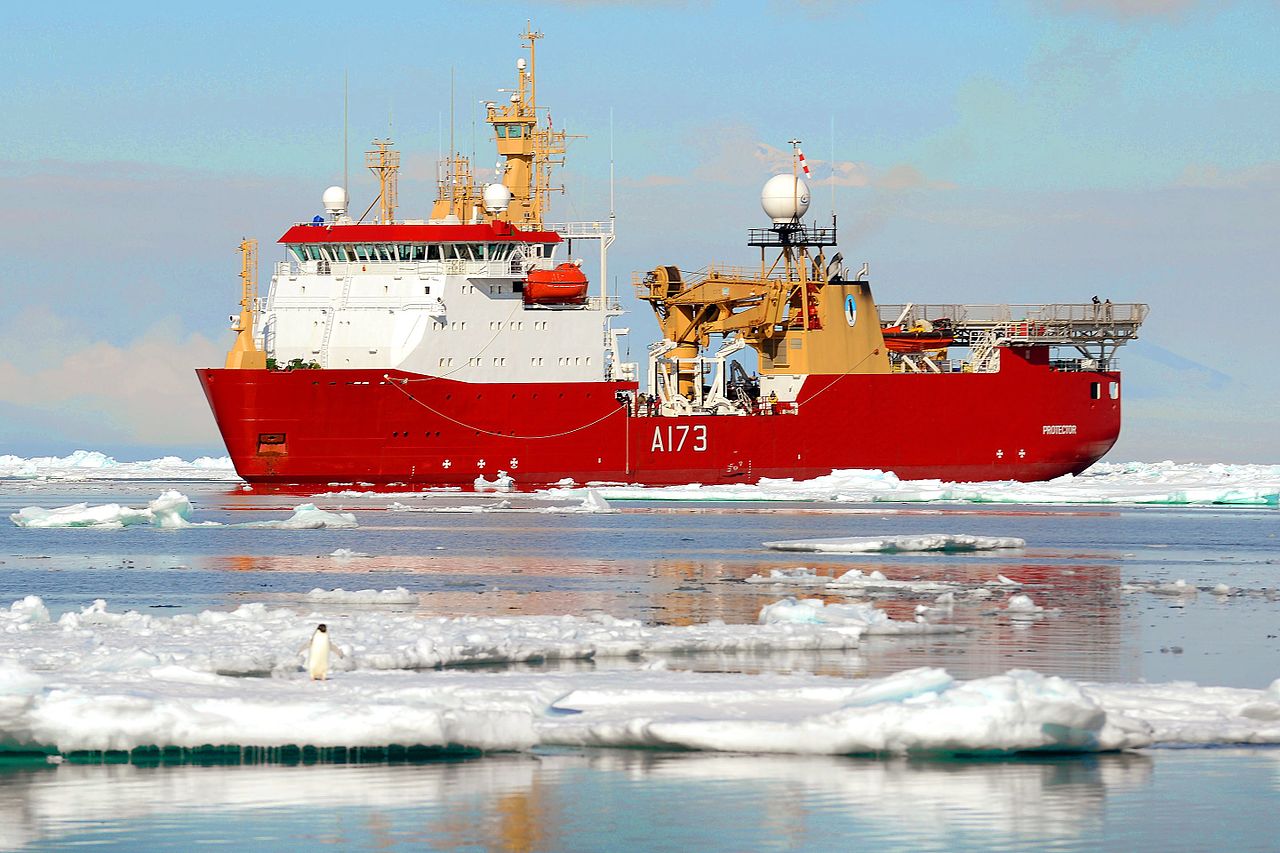
HMS Protector in the Antarctic
On the whole, the Royal Navy and Royal Marines give Britain an effective and well-balanced force, capable of projecting power worldwide. Only the US and China are ahead of Britain in this, and the men and women of the RN can carry on a proud tradition that stretches back almost half a millennium.
1 There is talk of fitting a light catapult and arrestor wires for UAVs. It's not clear what will come of this. ⇑
2 Not part of the RN, but also deserving mention, are two more units. First, the RAF supplies Britain's land-based naval aviation in the form of the Poseidon MRA1, bought as a replacement for the disastrous Nimrod. Second, the air groups on the Queen Elizabeths are made up of a mix of Fleet Air Arm (RN) F-35Bs, RAF F-35Bs and F-35Bs from the US Marine Corps, a truly unprecedented display of international (and interservice) cooperation. ⇑
3 Technically, she's a "Primary Casualty Receiving Ship" instead of a hospital ship so she doesn't have to comply with the requirements for that type under international law. ⇑

Comments
I love this series; I hope 'IJN today' is next. I am curious how far down the food chain you are planning to go (I am hoping Brasil and the Agean navies get their day in the sun). I don't envy you trying figure out what is good and what is rotten when you the Russia article.
Also, how well integrated is the Royal Navy with the various dominion navies?
IJN isn't a bad one to try. As for Russia, that depends on when the good folks at Seaforth do a deep dive in one of their annuals.
They're serious partner navies. I wouldn't be surprised to see a Canadian or Australian escort with a UK carrier group, for instance. But in practical terms, the same is true of a lot of other navies, and the first carrier group had American and Dutch escorts. There may be some more formal on-paper ties, but I'm not familiar with the details.
On rereading, I feel like Britain's half dozen strategically located colonial bases deserve mentioning.
ike:
bean:
Not having existed since 1945 does make for a short article about how it is today.
:-P
That's amazing. I was just looking at Nord Stream and was about to ask in the open thread if anyone was building ships with undersea pipeline/cables in mind.
Re Britain's colonies, I don't think any of the remaining ones except for Diego Garcia are particularly strategically useful, and the Falklands at least are definitely a net drain. (Not to say they should get rid of it by any means. But the strategic purpose there has been gone for decades.)
This is what happens when I don't get enough sleep. I will consider the JMSDF for an upcoming post.
Arguably Gibraltar doesn't give NATO anything that Rota couldn't, but it's quite a good spot for Britain, aside from it irritating the Spanish. I suppose Diego Garcia upsets the Mauritanians, too though.
The Royal Navy has a pattern of not arming it's warships as extensively as the US, to the point where they have a special acronym (FFBNW) to describe the practice. This means that while the Type 45 is in some ways the equal of a Burke, it has very limited ASW, land attack, or anti-ship ability. In fact once the harpoons are retired (next year?) the surface combatants are kind of relying on their guns for anything other than air defence. Though that still leaves aircraft and, more seriously, the submarines.
Oh, right. Forgot about Gibraltar, because see above re tired. I should make sure to check the list next time.
Fitted for but not with can make sense in some circumstances, although I do think the British tend to take it too far. As for Harpoon, remember that a SAM is an ASM in disguise, and don't worry too much about the loss in capabilities. These days, it's not really that much of a downgrade.
HMS Liverpool was attacked from shore and replied with only her gun multiple times in 2011, which I thought surprisingly late for a major warship to be using a gun on an actual threat to her, but given that the land forces were using unguided rockets, they possibly weren't considered a serious threat. (Anyone know of a later or less ambiguous example? I don't know of any others after 1991 (and there are conflicting accounts of that one), but haven't particularly looked.)
I would argue that Bermuda, Ascension, & Malta are all very nicely placed, especially keeping in mind air-to-air-refueling shenanigans. All-be-it, they are far from where we expect war.
re: Falkland
Yeah, you would think sitting on the throat of one of the Ocean's major choke points would count for more than it does. It is hard to imagine a situation where an enemy would want to use The Horn in preference to Panama or Cape Town.
bean:
There are nearby hydrocarbon resources.
ike:
Two of them are independent countries now.
Bermuda and Ascension are useful in certain cases, although neither is anywhere particularly interesting these days.
@muddywaters
I suspect that it wasn't much of a threat. Moving targets are hard to hit without specialized training/practice, and the Libyan military had a reputation for spectacular incompetence even by the low standards of the Arab world.
No, you're probably thinking of the Bahamas. Bermuda is still a British Overseas Territory. Malta, yes, is independent. (Meant to point that out and missed.)
As for the Falklands, I was thinking from a strategic point of view. No comment on economic aspects.
Great post as always. What’s the rationale behind splitting ships between the Aster and the Sea Ceptor? They seem very similar to each other.
@JoanSam Aster was around first, when CAMM/Sea Ceptor didn't exist, and I think that Aster 30 still has significant performance advantages. Perhaps comparable to the difference between Standard and ESSM? I believe that there is some suggestion that the Darings could get Sea Ceptor, either quad packed in some of the Silver cells, or in their own dedicated launcher in the space originally reserved for the Mk41 VLS (which was FFBNW).
@muddywaters interesting example that I wasn't aware of. In fact, I thought the Type 42s were out of service by then, which was clearly wrong, though I wasn't too far off.
@Bean I don't know if Aster has been tested in the anti-surface role, though Standard clearly can do the job. I'd still prefer some Tomahawks as well, which I think can hit ships as well as land targets.
Britain primarily (maybe even exclusively) uses the Aster 30, which is in the same class as the SM-2MR. Sea Ceptor is definitely ESSM class.
@Alexander
Re Aster anti-ship, I don't know for certain those tests have been run, but it's a very normal capability to have on modern SAMs.
More broadly, if I'd been in charge of the Type 45 program, I probably would have shown up at the Pentagon with the credit card and a request for a bunch of Aegis systems, Mk 41 and all. I know that SAMPSON has advantages over it, but I think on the whole that would have been a better choice, for Tomahawk if nothing else. As for Tomahawk specifically, the anti-ship version is, AIUI, still being tested. If it is in service, it's a very limited number of missiles. That said, it's a capability I'm surprised the RN hasn't gotten for its surface ships yet, and one that I would have prioritized years ago if I was at the Admiralty.
I don't know how the systems fit together. Could you have SAMPSON with Aegis instead of SPY-1? Or use Tomahawk with PAAMS? But either way, the (full length) Mk41 seems better than Sylver (looks like the autocorrect messed up my spelling in the last post) as it can fit Tomahawk, which would let us avoid the whole FCASW thing. Not to mention the option of BMD capable SM-3, and commonality advantages with the Type 26, and perhaps even 31/32.
I suspect there's enough integration between radar and combat system that SAMPSON/Aegis wouldn't work. Most notably, every Aegis ship uses SPY-1/6/7. That said, you can integrate the same missile/launch system into different ships, as evidenced by the use of Standard by the Germans and Dutch. Choosing Aster/Sylver over Standard/Mk 41 was the bigger mistake than SAMPSON over Aegis. I'd probably still have gone with Aegis (BMD is built in, for one thing) but I am still baffled by how little interest the RN has shown in surface Tomahawk capability.
Or maybe there's a sensible explanation (or as sensible as we can get at this level of defense policy, anyway). They've spent most of the last 30 years trying to get a proper strike carrier capability again. It would be easy for Parliament to decide that Tomahawk was a perfectly adequate substitute for the carriers, and much cheaper than buying QE and POW. In most countries, they could probably have started pushing for Tomahawk about 10 years ago without jeopardizing the carriers, but given British defense politics (POW was slated to be mothballed as recently as 2014) it probably hasn't been safe to do so until quite recently.
You should include stat blocks with these. Tonnage, number of ships, number of people, VLS cell count.
@cursedcassander: follow the links to Wikipedia.
How many times do I have to say that I'm not Jane's? Because I don't get paid enough to be them.
@muddywaters
We do this thing where he asks me to do work for him that I don't want to do, and I tell him to do it himself.
Also, if you didn't see the OT, would you mind sending me an email?
I look on Navylookout.com whenever I worry the US military acquisition system is hopelessly screwed up. The Brits make the US look good, and that is not a good thing with China building an equivalent of half the Royal Navy annually while the USN can't seem to get its act together building 2 subs & 2 Burkes annually.
@Jack: if the Brits aren't good enough medicine to lift your spirits, try the Canadians. And if that still won't do the trick, the final prescription is the Indians.
@muddy
wiki is useless for that sort of thing. Also what bean said.
@jack, if you really want to feel good, you should look at the canadians and their 5 billion dollar frigates.
Thanks for the blog. Love the blog.
I think the thing I would have liked from articles like this is some value judgement. Did the RN spend it's money wisely, is their hardware appropriate to the task, can they actually operate the stuff at reasonable availability rates (Looking at you Luftwaffe), etc.
The RN has historically had issues with spending money wisely, although I think both the Type 26 and Type 31 are very good designs. Hardware is generally appropriate, although if I was them, I'd want more serious air-defense capability. As for availability, it's pretty decent.
Re At Sea Deterrent
This is probably not public knowledge, but do they (and the French, who also have 4x SSBN) actually manage to keep one ship at sea and submerged continuously? I know that's the idea, and I assume the deterrent force gets first crack at both people and funding, so more likely for them than the surface fleet. But it's not like subs are immune to maintenance delays either. (I suppose you also get some benefit by being able to count training / workup missions?)
(I know to some extent this is mitigated by the ability to launch from the dock, as a very expensive ICBM, but that's not the point.)
The British claim they've had one continuously at sea since April 1969. No clue on the French.
If there were no maintenance delays maybe they could do it with 3 units.
Three units would have left occasional gaps of a few weeks ever 4 years or so, but also very little margin for things going wrong.